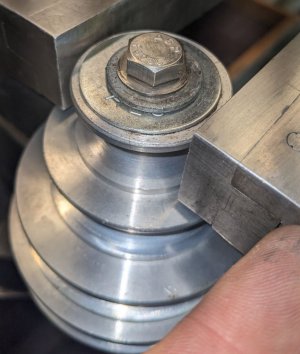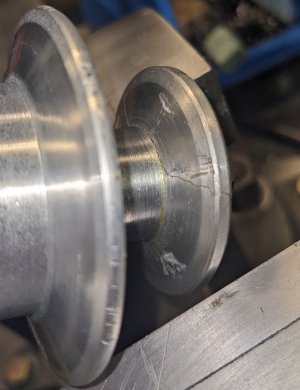Hilariously dumb thing: I hooked up the VFD today and tested it. This VFD (a KBDA-27d from KB Electronics) had already been programmed for a motor to use on a belt-grinder project, that I haven't started yet, it's on the way-back burner. Its LED display was set to read in surface feet per minute, a useful number to know on a belt, but useless on a mill. I figured I'd set that back to reading frequency later, not important for now, so I'll leave it on sfpm. In a hurry to play with my new toy. Not dumb on its own, but it
hid from me the fact that I'd also set the max frequency to 120 Hz. Again, a useful number on a belt machine, but all my other VFDs are set to 90 Hz max, and I forgot this one was 120.
The next dumb thing I did, I put the belt on the highest speed position (1-8) and cranked the VFD up to the max, which I figured would be about 3800 spindle RPM. I wasn't going to leave it there for long, just wanted to see if it could do it, what it would sound like. Yes, kinda risky at 3800 rpm, but insane at the 5200 rpm I actually got.
As soon as it reached full speed I heard a loud sharp
crack! and I shut it down, assuming I'd broken something important. Took me a while to notice that the little magnet I'd glued to the spindle pulley for the tachometer sensor wasn't there anymore. The crack I heard was when that magnet hit the wall at 120 mph (rough calculation). Good thing it wasn't pointed at my face when the glue let go. I had safety glasses on, under a polycarbonate face shield, but I still wouldn't want to take a tiny metal frisbee to the head at 120.
So lets count all the dumb things I did.
- Took the belt guard off, cuz you know, it's in the way and what could possibly go wrong? Real Men don't use guards, right?

- Glued that magnet on without milling a little counterbore for it to nestle into, so it was just surface mounted, no side support.
- Cranked the spindle up to a much higher rpm than I thought I was getting, because I was in too much of a hurry to change the display.
I've set up 5 VFDs now from factory defaults, but I've never reprogrammed one that was previously set for another machine. Maybe I should learn how to do a Factory Reset, so there aren't weird settings left over from whatever machine it was prgrammed for. Anyone know if that's an option with a KB? Do they have a KnowledgeBase (a "KB KB"?)
I've heard of people getting supposedly new VFDs, then finding there was some setting not at factory defaults. Maybe indicating that what they received was actually one returned to the seller, and repackaged as new. Unethical for a seller to do that, but we know it happens sometimes. Maybe a Factory Reset should be the first step in setting up any VFD, even if you think it's new — but especially if some idiot (like me) has worked on it previously.
Now to find that damn magnet. Maybe I'll find it out in the garden, and a tiny hole in the outside wall of my house?


